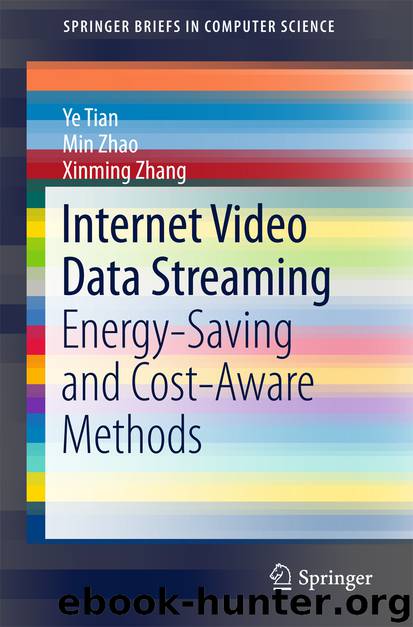Internet Video Data Streaming by Ye Tian Min Zhao & Xinming Zhang

Author:Ye Tian, Min Zhao & Xinming Zhang
Language: eng
Format: epub
Publisher: Springer Singapore, Singapore
3.2 Energy Saving for CDN
3.2.1 Energy-Aware Load Balancing
Mathew et al. [9] also address the energy saving problem for CDN. More specifically, an energy-aware CDN should turn off content servers during periods of low workload while seeking to balance three key design goals: maximize energy reduction, minimize the impact on client-perceived service availability (SLAs), and limit the frequency of on-off server transitions to reduce wear-and-tear and its impact on hardware reliability.
The authors propose energy-aware CDN load-balancing algorithms in two stages. The local load balancing algorithm works within a CDN server cluster, and makes decisions on hibernating and waking up servers based on past and current workload, then the global energy-aware load balancing algorithm redistributes traffic across clusters according to real-time cluster capacities. Evaluation using Akamai CDN workload shows that by holding an extra 10% of the servers as live spares, the local load balancing algorithm achieves a system-wide energy reduction of 55% and a service availability of at least five nine’s (99.999%), while incurring an average of at most 1 transition per server per day. Although having limited impact on energy reduction, the global load balancing algorithm can reduce 10–25% server transitions by redistributing workload across proximal clusters.
Download
This site does not store any files on its server. We only index and link to content provided by other sites. Please contact the content providers to delete copyright contents if any and email us, we'll remove relevant links or contents immediately.
Algorithms of the Intelligent Web by Haralambos Marmanis;Dmitry Babenko(8522)
Test-Driven Development with Java by Alan Mellor(7404)
Data Augmentation with Python by Duc Haba(7298)
Principles of Data Fabric by Sonia Mezzetta(7047)
Learn Blender Simulations the Right Way by Stephen Pearson(6983)
Microservices with Spring Boot 3 and Spring Cloud by Magnus Larsson(6802)
RPA Solution Architect's Handbook by Sachin Sahgal(6215)
Hadoop in Practice by Alex Holmes(6031)
The Infinite Retina by Robert Scoble Irena Cronin(5914)
Jquery UI in Action : Master the concepts Of Jquery UI: A Step By Step Approach by ANMOL GOYAL(5873)
Big Data Analysis with Python by Ivan Marin(5720)
Life 3.0: Being Human in the Age of Artificial Intelligence by Tegmark Max(5402)
Pretrain Vision and Large Language Models in Python by Emily Webber(4683)
Infrastructure as Code for Beginners by Russ McKendrick(4462)
WordPress Plugin Development Cookbook by Yannick Lefebvre(4194)
Functional Programming in JavaScript by Mantyla Dan(4124)
The Age of Surveillance Capitalism by Shoshana Zuboff(4116)
Embracing Microservices Design by Ovais Mehboob Ahmed Khan Nabil Siddiqui and Timothy Oleson(3981)
Applied Machine Learning for Healthcare and Life Sciences Using AWS by Ujjwal Ratan(3958)
